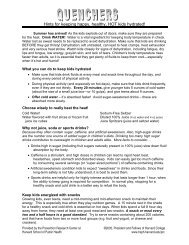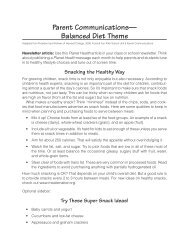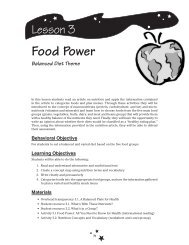<strong>Passing</strong> <strong>the</strong> <strong>Sugar</strong>Name ______________________________________<strong>Sugar</strong>y Sport Drinks?As you read <strong>the</strong> following essay, circle any words that are new to you and underline at least fivekey points.In <strong>19</strong>71 water bottles and sport drinks had not been invented yet, so when 14-year-old Lynne Coxand her teammates prepared for <strong>the</strong>ir 26-mile (41.6-kilometer) swim across <strong>the</strong> Catalina Channelin California, <strong>the</strong>y had to figure out how to get <strong>the</strong> fluids and energy <strong>the</strong>y needed during <strong>the</strong>ir 121/2 hours in <strong>the</strong> water. To complicate matters, <strong>the</strong> water temperature was 55 to 60 o F (13 to 16°C), so <strong>the</strong>y had to worry about how to maintain <strong>the</strong>ir body temperature as well. “We . . . filledplastic ketchup bottles with hot tea with sugar, warm orange juice, beef broth, hot apple cider, hotchocolate, and coffee loaded with sugar. We were trying to figure out what we could use on <strong>the</strong>Catalina crossing to boost our blood sugar and replace lost heat. With salt water in our mouthsfrom swimming in <strong>the</strong> sea, <strong>the</strong> orange juice was absolutely disgusting, beef broth was bad, andhot chocolate was a real mistake because it contained milk solids, which were known to makeswimmers nauseated. We narrowed our choices to coffee, tea, and hot cider.” A year later, whenLynne broke <strong>the</strong> world record for crossing <strong>the</strong> English Channel, she drank hot apple juice andate oatmeal cookies that were tossed to her.Today long-distances athletes and o<strong>the</strong>rs working for long periods in <strong>the</strong> heat are lucky; <strong>the</strong>ycan go to any corner store and purchase sport drinks that are specially formulated to quicklydeliver sugar to working muscles and replenish <strong>the</strong> water lost through sweating. The AmericanCollege of Sports Medicine recommends drinking sport drinks when you exercise strenuouslyfor more than 60 minutes. They recommend drinking water during shorter bouts of exercise or attimes when you are physically active at more moderate intensities, such as playing baseball orriding your bike for fun. Sport drinks do not improve your performance in <strong>the</strong>se situations. Youdon’t need <strong>the</strong> sugar; your body has enough stored energy. During recreational activities that lastseveral hours, it’s best to stop for a healthy snack to refuel your body.As sport drinks have become more plentiful, many children and adults are drinking when <strong>the</strong>ydon’t need <strong>the</strong>m. They are also drinking more of o<strong>the</strong>r kinds of sugar-sweetened beverages, suchas soda and fruit punches. Youth currently drink twice as much soda as milk. The excess sugarin <strong>the</strong>se drinks is creating health problems in children and teens that used to show up only inolder adults.<strong>Sugar</strong> and Body ChemistryGlucose, fructose, maltose, and sucrose are examples of sugars commonly found in <strong>the</strong> foodsand drinks we consume. They are added in large quantities to soda, sport drinks, cookies, andcandies, but occur naturally in dairy foods, fruits, vegetables, and o<strong>the</strong>r foods made from plants.<strong>Sugar</strong>s are simple carbohydrates. They are composed of one or two small molecules that containcarbon, oxygen, and hydrogen.Because of <strong>the</strong>ir small size and shape, sugar molecules are easily transported through <strong>the</strong> cellslining <strong>the</strong> small intestines and into <strong>the</strong> blood. Complex carbohydrate, such as <strong>the</strong> starch found ingrains and vegetables, is made up of long chains of simple sugars linked toge<strong>the</strong>r. These largemolecules must be broken down into simple sugars by digestive enzymes in <strong>the</strong> small intestinesbefore <strong>the</strong>y can enter <strong>the</strong> blood. <strong>Sugar</strong>s dissolve in blood and are pumped throughout <strong>the</strong> body.After a meal, blood sugar levels rise, and this stimulates cells in <strong>the</strong> pancreas to release a hormonecalled insulin into <strong>the</strong> blood. Insulin binds to cells in muscle, liver, and many o<strong>the</strong>r tissues,making <strong>the</strong>ir membranes more permeable to sugar. It acts like a doorman helping sugar get outFrom J. Carter, J. Wiecha, K. Peterson, S. Nobrega, and S. Gortmaker, 2007, <strong>Planet</strong> <strong>Health</strong>, 2nd ed. (Champaign, IL: Human Kinetics).From L. Cox, 2004, Swimming to Antarctica: Tales of a long-distance swimmer (New York: Alfred A. Knopf).254Activity <strong>19</strong>.2(continued)
<strong>Passing</strong> <strong>the</strong> <strong>Sugar</strong><strong>Sugar</strong>y Sport Drinks? (continued)Activity <strong>19</strong>.2of <strong>the</strong> blood and go inside <strong>the</strong> cells. Cells break down <strong>the</strong> sugar molecules and use <strong>the</strong> energyreleased to grow, to reproduce, and for many o<strong>the</strong>r functions. The brain uses sugar moleculesexclusively for energy. During exercise, sugar supplies muscle cells with most of <strong>the</strong> energy <strong>the</strong>yneed for contraction.<strong>Health</strong> RisksMaintaining normal blood sugar is vital to health; eating sugar is not. Scientists have discoveredthat regularly drinking sugar-sweetened beverages increases <strong>the</strong> risk of gaining excess weight anddeveloping type 2 diabetes, a chronic disease that used to be called adult-onset diabetes, but isnow showing up in youth. This type of diabetes is associated with obesity, lack of exercise, and oldage and it tends to run in families. It should not be confused with ano<strong>the</strong>r form of diabetes calledtype 1, or juvenile, diabetes. Type 1 diabetes typically shows up in children or young adults andis thought to be triggered by exposure to environmental factors, possibly an unknown virus.Diabetics have difficulty keeping <strong>the</strong>ir blood sugar at a healthy level. After a meal or drink thatcontains carbohydrate, blood sugar levels rise. In healthy people, this stimulates <strong>the</strong> pancreasto release insulin into <strong>the</strong> blood, which in turn helps sugar enter cells and returns blood sugarback to premeal levels. Diabetics ei<strong>the</strong>r don’t make enough insulin or are resistant to <strong>the</strong> insulin<strong>the</strong>y make. As a result, sugar builds up in <strong>the</strong>ir blood. With sugar unavailable to <strong>the</strong> cells, <strong>the</strong>body breaks down fat for energy, producing chemicals that make <strong>the</strong> blood more acidic, whichcan be fatal. Chronic high blood sugar can cause heart disease, blindness, kidney disease, andlower-extremity amputations.To help prevent type 2 diabetes, do <strong>the</strong> following:• Eat a healthy diet, including plenty of whole grains, vegetables, and fruits. Limit foods thatare high in added sugars to small quantities, and don’t have <strong>the</strong>m every day.• Get plenty of exercise.• Keep a healthy weight. If you’re overweight, ask for help from your parents and your doctorto get to a healthier weight.• Know your family history. If diabetes is in your family, be sure to get your blood checkedperiodically as you get older to monitor your blood glucose levels.Sport drinks were plentiful when Lynne Cox swam <strong>the</strong> first Antarctic mile in 2002, but she didn’tneed <strong>the</strong>m. The meal she ate before <strong>the</strong> swim provided her with all <strong>the</strong> energy she needed duringher 25-minute swim in water that was 32 °F (0 °C). Sport drinks are only recommended for strenuousexercise lasting longer than 60 minutes.Nutrition Tips for Improving Your Fitness and Performance• Drink plenty of water before, during, and after physical activity.• Eat foods from each of <strong>the</strong> five food groups at every meal.• Choose whole grains over processed grains.• Choose plant oils over animal fat.• Time your meals so that you eat 90 minutes or more before a competition.(continued)From J. Carter, J. Wiecha, K. Peterson, S. Nobrega, and S. Gortmaker, 2007, <strong>Planet</strong> <strong>Health</strong>, 2nd ed. (Champaign, IL: Human Kinetics).From L. Cox, 2004, Swimming to Antarctica: Tales of a long-distance swimmer (New York: Alfred A. Knopf).255





